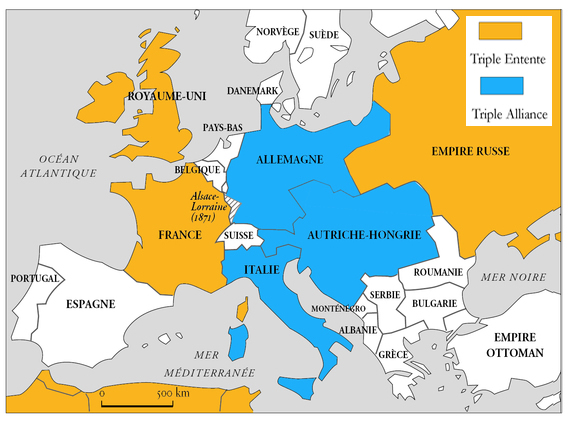 |
| Triple Alliance and Triple Entente (1882) |
Between 1882 and 1914 western Europe divided between the Triple Entente and the Triple Alliance. The division allowed the preservation of an uneasy peace despite periodic disruptions, particularly in the Balkans.
The map of Europe experienced major alterations in 1871 with the creation of the German Empire and the kingdom of Italy. Under Otto von Bismarck Germany’s main foreign policy goal was to keep France from becoming strong enough to take revenge for the Franco-Prussian War (1870–71) defeat and to fulfill its desire to retake Alsace and Lorraine.
Germany allied with Austria-Hungary and Russia in the Three Emperors’ League. Russia and Austria-Hungary, however, were at odds with one another over the Balkans and the Russian-backed Pan-Slavic movement, which threatened to break up the multinational Austria-Hungary by unifying Slavs.
 |
Pan-Slavism became a greater menace after the Treaty of San Stefano (1878) created a Bulgarian state. The Congress of Berlin in 1878 broke the Three Emperors’ League. In 1879 Bismarck and Austria-Hungary formed the secret Dual Alliance.
Germany and Austria-Hungary shared extensive common borders. Many regions of Austria were German-speaking, and both wanted to expand; Austria particularly had territorial ambitions in the Balkans. However, Austria was a fading empire, while Germany was young and ambitious. Germany soon dominated the alliance.
Italy joined the Dual Alliance to form the Triple Alliance in 1882. Italy was an off-and-on enemy of Austria because it coveted the same lands, but France occupied Tunisia in 1881 and blocked Italy’s ambitions for an African empire. The Triple Alliance eased differences between Italy and Austria and gave Italy promises of aid against French aggression. Italy’s promise of aid against French attack helped Germany, whose agreement with Austria had no mutual assistance provision.
The treaty was secret and temporary. The signatories renewed it in 1887 and 1903. In 1903 Italy canceled its promise to assist Germany against a French attack. In 1902 France secretly gave Italy free rein in Tripoli (present-day Libya in North Africa), thereby ending Italy’s anger at France. Italy was free to resume its rivalry with Austria in the Adriatic.
In 1882 Serbia joined a treaty with Austria- Hungary. Romania joined in 1883. The result was a powerful bloc in central Europe. Such a powerful combination called for a counterweight, and the powers on the periphery—France, Russia, and Britain— responded accordingly.
The Triple Alliance collapsed in 1914 at the onset of World War I when Italy argued that Serbia committed no aggression and declined to join her partners in war. The remaining alliance powers held together against the Triple Entente.
When Germany refused to renew its treaty with Russia, Russia turned to France, which wanted an ally against a united and hostile central Europe. The two signed an understanding in 1891, a military agreement in 1893, and the Franco-Russian Dual Alliance of 1894, made public in 1895.
Germany under Wilhelm II was aggressively seeking colonies and building a powerful navy. In response, the traditionally standoffish Britain sought allies. France was a traditional enemy and current rival in Africa. Anti-German Théophile Delcasse became French foreign minister in 1898.
In 1901 Francophile Edward VII became king of Great Britain. In 1904 France and Britain signed the Entente Cordiale, an agreement of friendship but not military aid. After Russia lost the Russo-Japanese War, English rivalries with Russia in Asia cooled. Russia joined the Triple Entente in 1907. Europe, therefore, was divided and ready for an event that would spark a major confrontation.